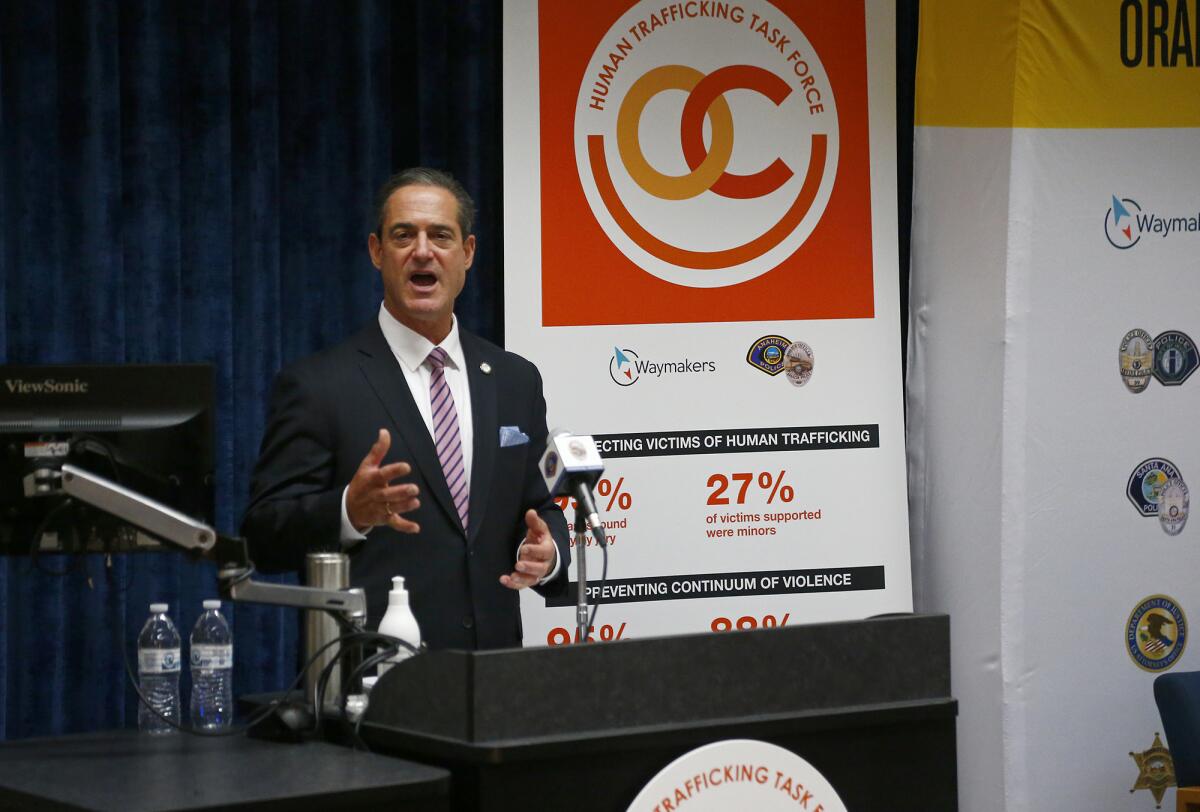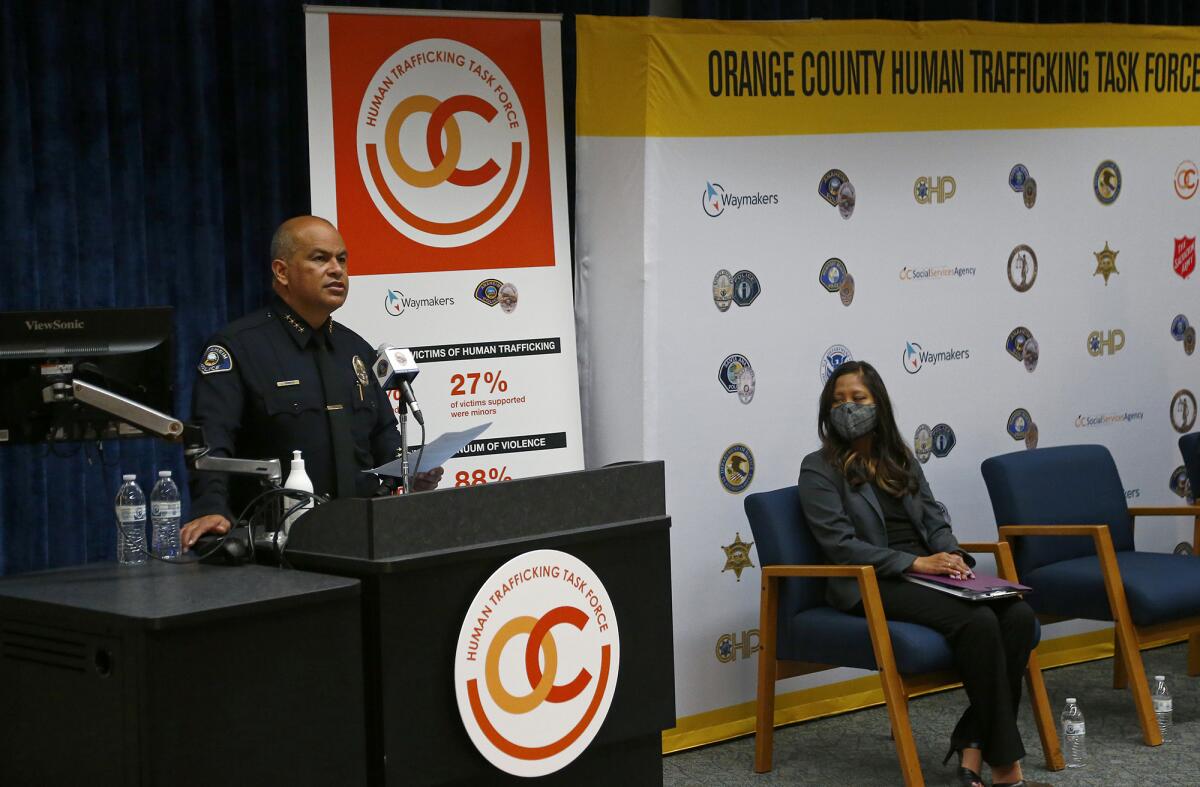Majority of sex and human trafficking victims in Orange County are Black and Latino, report says

- Share via
The majority of victims of human and sex trafficking identified by the Orange County Human Trafficking Task Force between 2016 and 2020 were Black and Latino, according to a recent report issued by the task force.
Each group accounted for 30% of the victims the task force assisted. White people accounted for 19%, Asian and Pacific Island people for 10% and those of “other” or mixed races for 11%.
“Human trafficking crosses all racial, ethnic, gender, socioeconomic and cultural lines,” the report says. “Human trafficking is about profit and abuse, it does not discriminate as long as it can sell. While it is important to emphasize that anyone can be a victim of trafficking or a targeted demographic based on their background, it is equally important to understand how racial and cultural dynamics intersect with human trafficking.”
The report highlights the last decade of work from the task force, which has grown to include more than 60 law enforcement agencies, victim service providers, nonprofits and other groups.
The task force was formed to combat human and sex trafficking in Orange County, which attracts the crime with its high tourism and affluent communities.
The report also states the COVID-19 pandemic made it difficult for the task force to assist victims last year. Officials in the task force said that may have resulted in fewer victims being identified than in previous years.
The task force assisted 357 sex and labor trafficking victims in 2019 and 2020. Of those victims, 330 were females and 101 victims were minors. The total number of victims is lower than the 415 victims the task force aided in the prior two years.
The lower number doesn’t necessarily reflect that the crime has declined. Officials in the task force stressed at a Monday press conference that the crime is still taking place in Orange County.
“The city of Anaheim and the county of Orange is a destination for numerous individuals that come here and during the pandemic period, obviously, everything was at a standstill,” Anaheim police Chief Jorge Cisneros said at the press conference. “But human trafficking is a lot more than just our visitors, so we continue to have the issue here.
“While the numbers may have decreased, we still have an issue that your local police departments are looking at and will continue to eradicate from our county...Yes, we are obviously a destination location, definitely the numbers dwindled as far as visitors, but human trafficking continues to occur in our communities regardless of the pandemic.”

In response to a question from a member of the media at the press conference, Orange County Dist. Atty. Todd Spitzer said the decreased number of aided victims during the pandemic doesn’t mean that the problem is any less substantial.
“Our arrests may have been down, our prosecutions, because of the pandemic, but that doesn’t mean you lay off our efforts to go after it,” Spitzer said.
The report also states that Waymakers and the Salvation Army had a difficult time providing services to victims due to the pandemic because they had to adapt their service models to comply with public health orders. For example, support groups for victims were moved online.
Waymakers and the Salvation Army are both on-call 24/7 to provide support to victims of sex and human trafficking.
“COVID-19 did have a direct impact on our ability as a victim service provider to be able to reach those victims that are in need of our services,” said Michelle Heater, program director for Waymakers’ Victim Assistance Programs.
In the past, prostitutes were targeted by law enforcement and put in jail for days. Now, authorities view sex workers as victims.
Spitzer said it became clear to authorities and the public that targeting consumers of sex work, also known as “johns,” and the people who control sex workers, known as “pimps,” are the best way to curb sex and human trafficking.
“We were caught up in that thought of putting people into the carceral system, and thinking that we would change behavior,” Spitzer said.

Heater said the task force takes a victim-centered, trauma-informed approach. Waymakers advocates work to connect with victims throughout the case.
“These adults that I have spoken to at all hours when called upon by law enforcement had dreams of being engineers, veterinarians and being people that helped others,” Heater said.
An unidentified victim was quoted in the task force’s report, stating that he or she was robbed of a childhood.
“Instead of going to school dances and having my first boyfriend, I was half naked on your local street corner,” the unidentified victim said. “I was exposed to domestic violence, drugs, and put my health at risk. I was a sophomore with a B average. My life took a plunge for the worse when I met the Defendant.
“I remember him being very angry and often times displaced his aggression on the other female. I remember being scared to tell my honest and truthful opinion to the Defendant in fear that I too would be beaten. There were times when the Defendant would have sexual intercourse with me. Even if I was too tired to engage I would submit to him in fear of being beaten.”
All the latest on Orange County from Orange County.
Get our free TimesOC newsletter.
You may occasionally receive promotional content from the Daily Pilot.






